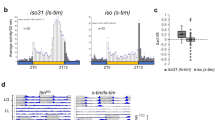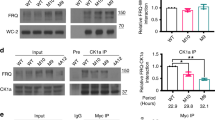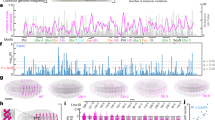Abstract
THE isolation and characterization of single gene mutations affecting the circadian biological clocks of several organisms (reviewed in ref. 1) has left little doubt that circadian rhythms can be subjected to classical genetical analysis. Many of these mutations occur at the same few genetic loci (frequency (frq) in the fungus Neurospora2, and period (per) in fruit fly Drosophila3); these loci represent the best studied clock-affecting genes known. Mutant strains are usually affected in more than one basic clock property1,4, suggesting an inter-relatedness at the molecular level among these basic properties that would not have been predicted a priori. The extensive background information available concerning the frq locus4 provides a basis for the molecular dissection of the Neurospora circadian clock—the most minimal circadian system thus far described. We report here the cloning and analysis of the frq locus and show it to be larger and more complex than would have been predicted from the available genetic data. Complete rescue of all of the pleiotropic mutant phenotypes5,6 of the recessive frq9 allele requires transformation with a 7.7-kilobase (kb) region of DNA encoding at least two transcripts. Sequence analysis of this region has allowed the identification of a common element between frq and per which, given the background similarities in their classical genetic characteristics, suggests the possibility of a common element in the clock mechanisms of these two organisms.
This is a preview of subscription content, access via your institution
Access options
Subscribe to this journal
Receive 51 print issues and online access
$199.00 per year
only $3.90 per issue
Buy this article
- Purchase on Springer Link
- Instant access to full article PDF
Prices may be subject to local taxes which are calculated during checkout
Similar content being viewed by others
References
Hall, J. C. & Rosbash, M. A. Rev. Neurosci. 11, 373–393 (1988).
Gardner, G. F. & Feldman, J. F. Genetics 96, 877–886 (1980).
Konopka, R. J. Fed. Proc. 38, 2602–2605 (1979).
Feldman, J. F. & Dunlap, J. C. Photochem. Photobiol. Rev. 7, 319–368 (1983).
Loros, J. J. & Feldman, J. F. J. biol. Rhythms 1, 187–198 (1986).
Loros, J. J., Richman, A. R. & Feldman, J. F. Genetics 14, 1095–1110 (1986).
Viebrock, A., Perz, A. & Siebald, W. A. EMBO J. 1, 565–571 (1982).
Perkins, D. D., Radford, A., Newmeyer, D. & Bjorkman, M. Microbiol. Rev. 46, 426–570 (1982).
Vollmer, S. J. & Yanofsky, C. Proc. natn. Acad. Sci. U.S.A. 83, 1–5 (1986).
Metzenberg, R. L., Stevens, J. N., Selker, E. U. & Morzycka-Wroblewska, E. Proc. natn. Acad. Sci. U.S.A. 82, 2067–2071 (1985).
Tinoco, I. et al. Nature New Biol. 246, 40–41 (1973).
Kozak, M. Molec. cell. Biol. 8, 2737–2744 (1988).
Orbach, M. J., Porro, E. A. & Yanofsky, C. Molec. cell. Biol. 6, 2452–2461 (1986).
Pearson, W. R. & Lipman, D. J. Proc. natn. Acad. Sci. U.S.A. 85, 2444–2448 (1988).
Lipman, W. J. & Pearson, W. R. Science 227, 1435–1441 (1985).
Doolittle, R. F. Of URFs and ORFS (University Science Books, Mill Valley, 1986).
Jackson, F. R., Bargiello, T. A., Yun, S. H. & Young, M. W. Nature 320, 185–188 (1986).
Citri, Y. et al. Nature 326, 42–47 (1987).
Reddy, P., Jacquier, A. C., Abovich, N., Petersen, G. & Rosbach, M. Cell 46, 53–61 (1986).
Gonzalez, G. A. et al. Nature 337, 749–752 (1989).
Dayhoff, M. O. in Atlas of Protein Sequence and Structure Vol. 5, suppl. 3. (ed. Dayhoff, M. O.) 1–8 (Natn. biomed. Res. Found., Silver Spring, 1978).
Shin, H. S., Bargiello, T. A., Clark, B. T., Jackson, F. R. & Young, M. W. Nature 317, 445–448 (1985).
Weber, M. L., deGroot, E. J. & Schweiger, H. G. Molec. gen. Genet. 209, 1–7 (1987).
McClung, R. M., Phillips, J. D., Orbach, M. J. & Dunlap, J. C. Expl. Mycol. (in the press).
Davis, R. L. & deSerres Meth. Enzym. 71A, 79–143 (1970).
Dunlap, J. C. & Feldman, J. F. Proc. Natn. Acad. Sci. U.S.A. 85, 1096–1100 (1988).
Loros, J. J., Denome, S. & Dunlap, J. C. Science 243, 385–388 (1989).
Hu, N. & Messing, J. Gene 17, 271–277 (1982).
Feng, D. F., Johnson, M. S. & Doolittle, R. F. J. molec. Evol. 21, 1112–125 (1985).
Schwartz, R. M. & Dayhoff, M. O. in Atlas of Protein Sequence and Structure Vol. 5, Suppl. 3 (ed. Dayhoff, M. O.) 353–358 (Natn. biomed. Res. Found, Silver Spring, 1978).
Henikoff, S. Gene 28, 351–359 (1984).
Sanger, F., Nicklen, S. & Coulson, A. R. Proc. natn. Acad. Sci. U.S.A. 74, 5463–5467 (1977).
Myers, E. & Miller, W. CABIOS 4, 11–17 (1988).
Author information
Authors and Affiliations
Rights and permissions
About this article
Cite this article
McClung, C., Fox, B. & Dunlap, J. The Neurospora clock gene frequency shares a sequence element with the Drosophila clock gene period. Nature 339, 558–562 (1989). https://doi.org/10.1038/339558a0
Received:
Accepted:
Issue Date:
DOI: https://doi.org/10.1038/339558a0
This article is cited by
-
Connecting virulence pathways to cell-cycle progression in the fungal pathogen Cryptococcus neoformans
Current Genetics (2017)
-
Synchronizing stochastic circadian oscillators in single cells of Neurospora crassa
Scientific Reports (2016)
-
Photoreceptor Apparatus of the Fungus Neurospora crassa
Molecular Biology (2005)
Comments
By submitting a comment you agree to abide by our Terms and Community Guidelines. If you find something abusive or that does not comply with our terms or guidelines please flag it as inappropriate.



